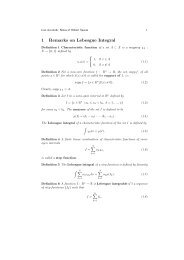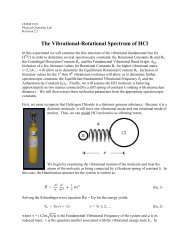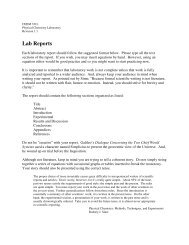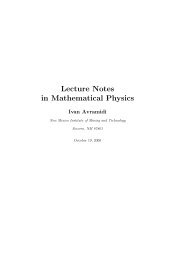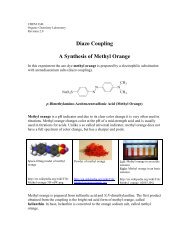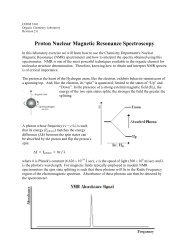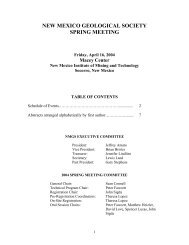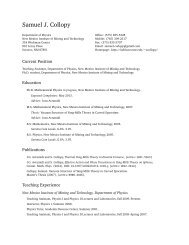– 20 –c s /v K ≈ r/H ≃ 280 at r ab , then the shocked matter will have a still higher entropy and be evenfurther radiation dom<strong>in</strong>ated. In a strong shock the energy beh<strong>in</strong>d the shock will be half k<strong>in</strong>eticand half <strong>in</strong>ternal energy, where <strong>in</strong> this case the radiation pressure dom<strong>in</strong>ates. Thus the subsequentevolution of the radiation dom<strong>in</strong>ated gas will be governed by adiabatic hydrodynamics of the fluidwith a polytropic <strong>in</strong>dex γ = 4/3.4.2. The Shock Produced by the Collision and Its Radial ExpansionS<strong>in</strong>ce the <strong>in</strong>itial radius of the shocked gas is that of the star and s<strong>in</strong>ce this radius is smallcompared to the path length through the disk, H, or H/R ⊙ ≈ 370 at r = r ab , we make theassumption that the collision can be approximated as a l<strong>in</strong>e source of energy with the energydeposition per unit length ΣvK 2 πR2 ⊙, and consider the shock wave as expand<strong>in</strong>g radially from thetrajectory axis. This can be well described as one of the sequence of Sedov solutions (Sedov 1959)of an expand<strong>in</strong>g cyl<strong>in</strong>drical shock <strong>in</strong> a uniform medium. However, for the purposes of the accuracyrequired for our plume approximation it is sufficient to note that the energy density left beh<strong>in</strong>dthe shock, ǫ shk , is nearly <strong>in</strong>versely proportional to the swept-up mass, or ǫ shk ≃ ǫ shk,R⊙ (R ⊙ /R shk ) 2where ǫ shk,R⊙ ≃ vK 2 /2. This <strong>in</strong>crease <strong>in</strong> energy density leads to an <strong>in</strong>crease <strong>in</strong> the pressure of theshocked gas P shk relative to the ambient pressure P o : P shk,R⊙ (z) ≃ ρvK 2 ≫ P o(z) for all z. The highpressure of the shocked gas near the axis of the channel will drive the shock to larger radii whileexpand<strong>in</strong>g adiabatically beh<strong>in</strong>d the shock. Near the surface, R shk ≃ z the shocked gas can expandvertically as well as horizontally. However, to the extent that when the shock is strong, R shk ≪ H,the radial shock will have decreased <strong>in</strong> strength before the star reaches the surface and the overpressure becomes too small except for a small mass fraction of the surface mass, ∆z ≃ R shk ≪ H,that will expand vertically above the disk surface.However, a larger mass will expand above the disk due to buoyancy. In this case the vertical momentumis derived primarily from the difference of gravitational forces on the buoyant matter versusthe ambient matter. The buoyant force is proportional to the entropy ratio. A strong shock leavesbeh<strong>in</strong>d matter whose entropy is higher than the ambient medium. S<strong>in</strong>ce the entropy change due toa shock wave is third order <strong>in</strong> the shock strength (Courant & Friedrichs 1948; Zeldovich & Raizer1967), only strong shocks result <strong>in</strong> significant changes <strong>in</strong> entropy. In this limit the entropy change∆S from the ambient entropy S o is ∆S/S o ∝ ∆(P/ρ)/(P o /ρ) ≃ (P shk /P o )((γ − 1)/(γ + 1)) whereγ is the usual ratio of specific heats, and ρ is the ambient density. The compression ratio isη CR = ρ shk /ρ = (γ + 1)/(γ − 1) = 7 across a strong shock for γ = 4/3. Thus, for example, fora plume to rise well above the disk requires an estimated ∆S/S o ≥ 2 and thus P shk /P o ≃ 14 .Once the hot shocked gas rises to the surface of the disk and assum<strong>in</strong>g that this flow is adiabaticthereafter and thus does not entra<strong>in</strong> a significant fraction of surround<strong>in</strong>g matter, the subsequentexpansion above the disk is determ<strong>in</strong>ed by its <strong>in</strong>itial <strong>in</strong>ternal energy.Let us consider the neighborhood of a po<strong>in</strong>t r = r 0 at the mid-plane of the disk where a stardisk collision occurs. One can <strong>in</strong>troduce a local Cartesian coord<strong>in</strong>ate system x, y, z <strong>in</strong> the Keplerian
– 21 –rotat<strong>in</strong>g frame with the orig<strong>in</strong> at the po<strong>in</strong>t r = r 0 such that the x-axis is directed radially outward,the y-axis is directed <strong>in</strong> the positive azimuthal direction, and the z-axis is perpendicular to the diskplane. Then, the effective gravitational and centrifugal potential <strong>in</strong> the Keplerian rotat<strong>in</strong>g frame<strong>in</strong> the neighborhood of the po<strong>in</strong>t r = r 0 is∆Φ = GM2r03 (z 2 − 3x 2 ). (21)The thermal energy of the hot column of gas is a fraction of the loss of k<strong>in</strong>etic energy of the stardue to the hydrodynamic collision with the disk. This latter energy loss dur<strong>in</strong>g one passage isF drag 2H = 2HπR 2 ⊙ρv 2 ∗ = πR 2 ⊙Σv 2 ∗.Without a hydrodynamic simulation <strong>in</strong> 3-dimensions an accurate description is miss<strong>in</strong>g. Neverthelessit is sufficient to approximate the solution as that fraction of the disk matter that hasan <strong>in</strong>ternal energy density, ǫ shk greater than that of the ambient disk by that factor such that itwill rise to a height, z, determ<strong>in</strong>ed by its potential energy, or ∆Φ = GMz22r 3 (equation (21)). S<strong>in</strong>ce∆S/S o = ǫ shk /ǫ o , where ǫ o ≃ ∆Φ(H) = GMH22r 3 , then <strong>in</strong> order for a plume to rise above the diskmid-plane to a height, l,( lH) 2≃(ǫshk)≃ǫ o( ) 2 ( ) 2 vK R⊙( r) ( ) 2 2 R⊙≃ . (22)c s R shk H R shkWe are concerned with plumes that rise well above the disk so that they can expand horizontallyby a factor several times the plume’s orig<strong>in</strong>al radius. In this case the moment of <strong>in</strong>ertia of theplume about its own axis will be <strong>in</strong>creased by several times before fall<strong>in</strong>g back to the disk. Thiscauses the plume to reduce its own rotation rate relative to the frame of the disk, that is to untwistrelative to that frame. For this expansion to take place, the plume must rise roughly ∼ 2H abovethe disk, or l ≃ 3H. At this height the pressure of the hydrostatic isothermal atmosphere with thedensity profile as ∝ exp(−z 2 /H 2 ) becomes negligible compared to that of the plume, and so thehot gas of the plume can expand both vertically and horizontally as a free expansion. With this lwe getR shk≃ 1 rR ⊙ 3 H . (23)Us<strong>in</strong>g expression (8) for H/r at r ≤ r ab we obta<strong>in</strong>R shk ≃ 0.24H( αss) ( ) (2/21−26/21lE(ǫ) 26/21−19/21 r M 8 1 −0.01 0.1 0.1 r ab√ ) −23rg, (24)Thus a plume, start<strong>in</strong>g from a size, R shk < H will expand to a size ≃ 2H both vertically andhorizontally, thus produc<strong>in</strong>g a near spherical bubble with radius r p = H above the disk. Post shockexpansion will <strong>in</strong>crease the estimate of R shk somewhat. For simplicity we will use R shk = H/2 forestimates of the toroidal flux entra<strong>in</strong>ed <strong>in</strong> the plumes <strong>in</strong> paper II. This is our standard plume.r




